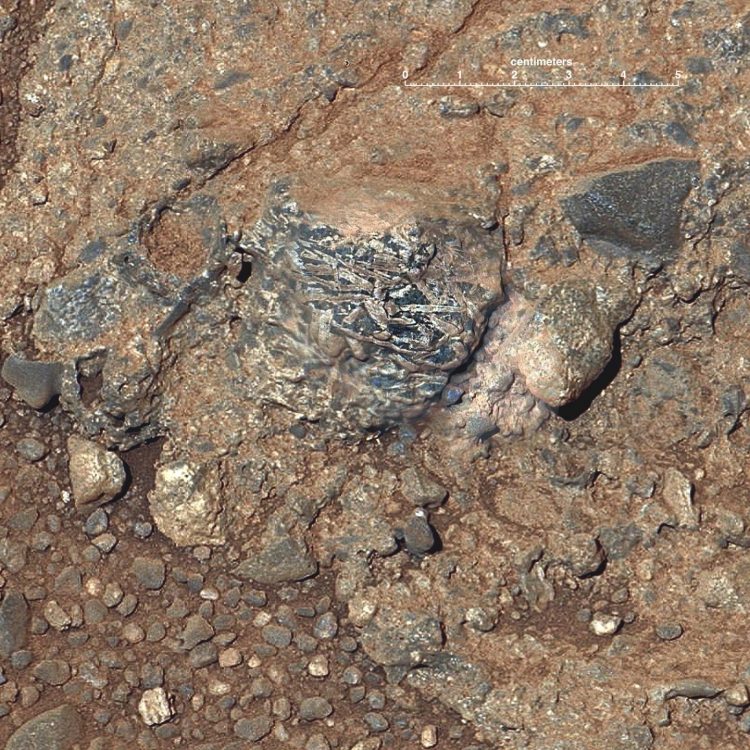Curiosity rover finds evidence of Mars' primitive continental crust

Igneous clast named Harrison embedded in a conglomerate rock in Gale crater, Mars, shows elongated light-toned feldspar crystals. The mosaic merges an image from Mastcam with higher-resolution images from ChemCam's Remote Micro-Imager. Credit: NASA/JPL-Caltech/LANL/IRAP/U. Nantes/IAS/MSSS
The ChemCam laser instrument on NASA's Curiosity rover has turned its beam onto some unusually light-colored rocks on Mars, and the results are surprisingly similar to Earth's granitic continental crust rocks. This is the first discovery of a potential “continental crust” on Mars.
“Along the rover's path we have seen some beautiful rocks with large, bright crystals, quite unexpected on Mars” said Roger Wiens of Los Alamos National Laboratory, lead scientist on the ChemCam instrument. “As a general rule, light-colored crystals are lower density, and these are abundant in igneous rocks that make up the Earth's continents.”
Mars has been viewed as an almost entirely basaltic planet, with igneous rocks that are dark and relatively dense, similar to those forming the Earth's oceanic crust, Wiens noted. However, Gale crater, where the Curiosity rover landed, contains fragments of very ancient igneous rocks (around 4 billion years old) that are distinctly light in color, which were analyzed by the ChemCam instrument.
French and US scientists observed images and chemical results of 22 of these rock fragments. They determined that these pale rocks are rich in feldspar, possibly with some quartz, and they are unexpectedly similar to Earth's granitic continental crust. According to the paper's first author, Violaine Sautter, these primitive Martian crustal components bear a strong resemblance to a terrestrial rock type known to geologists as TTG (Tonalite-Trondhjemite-Granodiorite), rocks that predominated in the terrestrial continental crust in the Archean era (more than 2.5 billion years ago).
The results were published this week in Nature Geoscience, “In situ evidence for continental crust on early Mars.”
Gale crater, excavated about 3.6 billion years ago into rocks of greater age, provided a window into the Red Planet's primitive crust. The crater walls provided a natural geological cut-away view 1-2 miles down into the crust. Access to some of these rocks, strewn along the rover's path, provided critical information that could not be observed by other means, such as by orbiting satellites.
###
ChemCam, a laser-induced breakdown spectrometer (LIBS), provides chemical analyses at a sub-millimeter scale; detailed images were provided by its Remote Micro Imager. Photo caption: Igneous clast named Harrison embedded in a conglomerate rock in Gale crater, Mars, shows elongated light-toned feldspar crystals. The mosaic merges an image from Mastcam with higher-resolution images from ChemCam's Remote Micro-Imager. Credit: NASA/JPL-Caltech/LANL/IRAP/U. Nantes/IAS/MSSS.
About Los Alamos National Laboratory
Los Alamos National Laboratory, a multidisciplinary research institution engaged in strategic science on behalf of national security, is operated by Los Alamos National Security, LLC, a team composed of Bechtel National, the University of California, The Babcock & Wilcox Company and URS Corporation for the Department of Energy's National Nuclear Security Administration.
Los Alamos enhances national security by ensuring the safety and reliability of the U.S. nuclear stockpile, developing technologies to reduce threats from weapons of mass destruction, and solving problems related to energy, environment, infrastructure, health and global security concerns.
Media Contact
All latest news from the category: Physics and Astronomy
This area deals with the fundamental laws and building blocks of nature and how they interact, the properties and the behavior of matter, and research into space and time and their structures.
innovations-report provides in-depth reports and articles on subjects such as astrophysics, laser technologies, nuclear, quantum, particle and solid-state physics, nanotechnologies, planetary research and findings (Mars, Venus) and developments related to the Hubble Telescope.
Newest articles

Properties of new materials for microchips
… can now be measured well. Reseachers of Delft University of Technology demonstrated measuring performance properties of ultrathin silicon membranes. Making ever smaller and more powerful chips requires new ultrathin…

Floating solar’s potential
… to support sustainable development by addressing climate, water, and energy goals holistically. A new study published this week in Nature Energy raises the potential for floating solar photovoltaics (FPV)…

Skyrmions move at record speeds
… a step towards the computing of the future. An international research team led by scientists from the CNRS1 has discovered that the magnetic nanobubbles2 known as skyrmions can be…





















